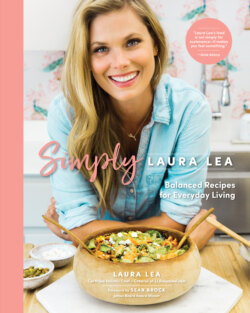Читать книгу Simply Laura Lea - Laura Lea - Страница 31
На сайте Литреса книга снята с продажи.
Оглавление3
Create a relaxed and happy eating environment—
practice intuitive eating!
This section is particularly near and dear to my heart.
Learning how to have a truly healthy relationship
with food can be a lifelong journey, and it’s one that
I’m still on! But I have figured out something crucial
in the last few years, which is that our behavior
around food isn’t about the food. It’s about the way
we approach the eating experience, and it’s about
our perspectives in relation to food. Once I digested
this (pun intended!), I realized the importance of
becoming an intuitive eater, which allows me to focus
on what my body really needs, instead of what my
brain thinks it should or wants it to need. Below you
will find my top tips and tricks for intuitive eating.
It is very difficult to become an intuitive eater
when you’re purchasing most of your food through
Postmates or grabbing it already packaged up in
shiny plastic. On the other hand, when you cook
your food from scratch, you can constantly tweak
and adjust and try new things, which is the best way
to know what works for you and your body. And if
you’ve struggled with your mindset around food, you
might also struggle with your mindset about cooking.
So I’ve included a list here of the top “Cooking
Mindset Myths” I’ve heard throughout my career,
as well as the truths that debunk them.
Intuitive Eating
A lot of us have heard of it, and pretty much all of
us like the sound of it . . . I mean, it’s a good thing,
right? Right. But the real question is, what does it
mean? What the gosh-darn-heck does it mean to
“eat intuitively”?
“Intuitive eating” is the reliance on physiologic
hunger and satiety cues to guide eating. Studies
have shown that the practice of intuitive eating
is correlated with improved mental health and
appropriate BMI (Body Mass Index).
Our culture has become increasingly distant from
real food and its origin. We grab our produce cleaned,
packaged, and presented on glossy supermarket
shelves; that is, when we even reach for produce at
all. Packaged “convenience” foods have become so
popular since the 1960s that now we have a tough time
determining what real food even is. I’d wager than many
people consider most packaged foods to be “real” food.
But most are not. Most packaged foods are full of
additives, chemicals, and synthetic ingredients. In
addition, most are completely devoid of nutrition.
Quite the double whammy, huh?
Even with the blessed rise of health-consciousness
in the US, which has led to a prevalence of health-
supportive packaged foods, there’s still a catch. I’m
sometimes more inclined to grab these boxed and
bagged items because they aren’t terrible for me.
Unfortunately, however, my body doesn’t respond
to such products in the same way as it does to
real foods. I don’t feel satiated and often want to
keep eating even if I’ve already consumed a high-
calorie meal. Many people are now overfed and
undernourished. Hunger and malnutrition are no
longer just the result of a calorie deficit, but instead
can result from a poor-quality diet.
Two decades into the 21st century, I believe that
“intuitive eating” has become a buzz phrase because
we’re recognizing this problem. The dieting culture
and encouragement of powders, pills, and bars seem
to have made it more difficult to know when we’re
truly nourished.
If this resonates with you, please know that you
haven’t done anything wrong. You’ve been set up for
this struggle, and there’s no blame game allowed,
only baby steps to proceed. Here are my top tips for
learning to tune into your body, tune out the social
media noise, and learn how to notice, decipher, and
trust your hunger cues.
